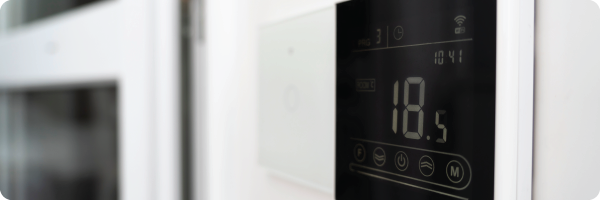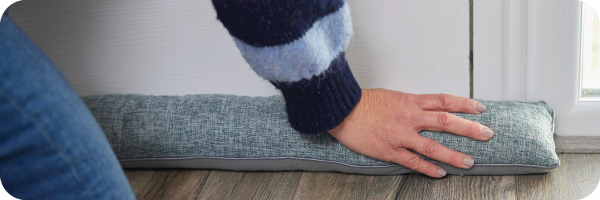The cold can have extra bite when you don’t have access to heating or fear sky-high energy bills. The effects of cold weather on our health, which we explore in this article, can also be worrying. We share some practical and cost-effective ways to stay warm indoors, if heating isn’t a feasible option.
What is the recommended indoor temperature?

It’s widely accepted that we should aim to heat our homes to a minimum of 18°C according to government guidance. The World Health Organization (WHO) states: “there is no demonstrable risk to human health of healthy sedentary people living in air temperature of between 18 and 24°C” .
Don’t worry if you’re unable to heat your home to 18°C – we share other ideas of how to keep warm just below.
How to stay warm indoors in winter without heating
Warm community hubs. Local authorities, businesses, civil society organisations and churches and other faith groups have banded together to offer free, warm, and welcoming spaces in local communities for anyone to attend. You can find a registered place near you here and filter your search to identify those with accessible toilets, child friendly facilities, parking and more.
Tips you can try at home:

Layer up. By that we mean pile on the layers, particularly clothes that provide good insulation, so fleeces, hoodies and jumpers. Your body will thank you for it! In case helpful, many local organisations, such as the Salvation Army, offer access to warm clothing banks.
Focus on fingers and toes. Think fluffy / thick socks, slippers and even gloves. As temperatures drop, your blood gets directed away from your fingers and toes to keep your critical organs warm. Though the myth that we lose 40-50% of our body heat through our head in cold weather was debunked, sporting a cosy hat can also help.
Eliminate draughts. It may be wise to invest in draught excluders (they come in different colours and patterns to suit your tastes!) or draught tape for doors and windows to stop heat escaping. Or, you may choose to have fun making your own draught excluders using old clothing, duvets, pillow cases or towels with elastic bands!
Warm up from the inside out. Enjoy warm drinks, hot soup or hearty stews brimming with healthy veggies and warm nutritious meals where possible.
Keep curtains and doors closed. Keeping doors shut and closing curtains in the evenings means they can act as another layer of insulation, retaining the heat in each room and blocking out any chilly draughts. Be sure to open them during the day though to take advantage of free heat from any winter sun streaming through your window.
Ensure your duvet is as thick as possible. If you’re able to, buying a duvet with a higher tog value can keep you at a comfortable temperature during cooler nights. Generally, the higher the duvet tog, the warmer and thicker the duvet filling will be to enjoy a good night’s sleep.
Roll out rugs. Hard cold flooring can feel freezing underfoot. Where possible lay out rugs or use old towels and bath mats.
Fill up that hot water bottle! Placing a hot water bottle in your bed 5-10 minutes before you go to sleep to warm it up (remembering to remove it before you get into bed) or placing it between your back and your chair while sitting at home can help you feel cosier.
Have fun getting active. Yoga, an online exercise video, high-intensity interval training (HIIT), even dancing, you name it, exercise and music get your blood pumping and boost your mood.
Keep on moving. As tempting as it may be to curl up under a thick blanket on the sofa, sweeping, mopping, vacuuming, or even giving your walls a lick of paint, keep you active and can make you feel productive too!
Tips to save money on your heating bills
Adjust your boiler: If you have a combi boiler (i.e one unit that provides both heat and hot water) the Heating Hub advises that reducing the “flow” temperature can make your gas usage more efficient.
See if you’re eligible for financial support. The government is offering eligible people £150 off their electricity bill for winter 2022 to 2023 under the Warm Home Discount Scheme. The support will come in the form of a one-off discount on your electricity bill, between October 2022 and March 2023.
Check if your utility companies are offering support. Some companies are acknowledging this may be a challenging time for their customers by encouraging them to get in touch if they’re finding paying their bills difficult. Citizen’s Advice also offers guidance on what financial help and support may be available to assist with the cost of living and Turn2Us signpost to lots of useful resources if you’re struggling to heat your home.
Now we’ve covered some ways to stay warm, let’s explore why it’s important for our health and wellbeing.
The effects of cold temperatures on the human body
The reason behind the recommended 18°C minimum temperature is that our bodies have to work much harder to raise our body temperatures below this threshold. This can have a profound impact on our cardiovascular, respiratory, immune, and cognitive health.
Heart problems and cold weather
As temperatures plummet, our blood pressure heads in the opposite direction. One study found that a 1°C decrease in living-room temperature was associated with rises of 1.3 mmHg in systolic blood pressure and 0.6 mmHg in diastolic blood pressure. What’s more, a review identified an association between raised blood pressure and exposure to indoor temperatures of around 18°C or colder in the general adult population. It also discovered that cold temperatures increase the risk of blood clotting in healthy people who are sedentary and wearing minimal clothing.
Indeed, when Professor Damian Bailey from the University of South Wales put BBC Radio 4’s Inside Health presenter, James Gallagher into an environmental chamber and gradually lowered the temperature from 21°C to 10°C, it yielded some interesting results. James’ mean arterial blood pressure (systolic and diastolic) shot up from 99 to 110 mmHg. James’s heart had to pump warm blood around his body more intensely as the temperature plunged meaning his heart was beating faster causing his blood pressure to rise.
Professor Bailey also explained that James’ blood changed with the cold “so it becomes a bit like treacle”, and this thicker gloopier blood also added to the risk of a dangerous blockage. Although Professor Bailey’s study was just carried out on one man, there’s evidence that chilly temperatures can make our blood’s platelets stick together more than usual. This increases the risk of developing dangerous blood clots.
This increase in blood pressure during colder spells may be one of the contributing factors to the rise in cardiovascular disease and strokes in the winter months.
What does all this mean for my heating habits?
The above highlights the importance of keeping warm during temperature dips. In fact, one review of multiple studies found lower ambient temperatures seem to increase adults’ blood pressure, and people with conditions related to cardiovascular disease are more susceptible to drops in temperature. Additionally, indoor temperature seemed to have a stronger effect on blood pressure than outdoor temperature, showing how essential warm homes are.
Research has found that systolic blood pressure in the morning may be more sensitive to changes in indoor temperature than that in the evening. So, should you have heating, you could benefit from prioritising morning heating over evening heating.
Other effects of cold weather on health
It’s not just our cardiovascular health that can be compromised in numbing indoor temperatures; WHO found colder indoor temperatures increased the chances of living with a condition that affects the lungs or impairs breathing.
Breathing in cool air as well as the body’s surface cooling, plus stress from cold (caused by lowering the body’s core temperature) can trigger responses such as the narrowing of blood vessels and suppress immune responses. This leads to an increased susceptibility to respiratory infections. Further research is still needed to explain why we’re more prone to respiratory infections in lower temperatures; it may be that viruses don’t thrive as well in higher temperatures or that our immune systems simply aren’t as effective when in prolonged cold environments.
On top of infections, coldness can impair lung function and, should you live with COPD and asthma already, your symptoms, such as narrowing of your airways (broncho-constriction), may increase. But there are some actions we can take to better support ourselves, highlighted below.
The dangers of damp
Damp and cold often go hand in hand. Damp itself can exacerbate respiratory conditions. Research examining 72 children with previously diagnosed asthma living in 59 damp houses found that all respiratory symptoms were significantly reduced after central heating was installed.
Damp forms where moisture collects but doesn’t have chance to fully dry out. For example, condensation develops on the coldest surfaces of a room first. So, if you’re able to, heating your home to at least 18°C during winter to reduce cold surfaces can help.
In damp conditions mould growths can produce harmful mycotoxins which can cause lung inflammation and potentially contribute to the development of asthma and respiratory infections , particularly in children.
If heating your home isn’t an option, try to focus on dehumidifying your home. If you have them, keep extractor fans running when cooking, showering or drying clothes indoors to allow air to circulate and minimise damp build-up, and keep doors shut to prevent moist air escaping into other rooms. You can find other ways to dehumidify you home here.
Colder temperatures and cognitive activity
The relationship between indoor temperature and cognitive performance remains complex. Cognitive performance (memory, verbal ability, reasoning, etc.) was found to be superior at 16°C-18°C compared to 20–22°C in one study.
Yet, some investigations have shown that, for regions with temperate or cold climate, cognitive and work performance is optimal between 22°C and 24°C. This may be because blood is prioritised for maintaining core body temperature, and thus less is pumped to the brain. In turn, this can result in a lower delivery of oxygen and nutrients.
What remains clear is that extremely low indoor temperatures of below 16°C are most likely not conducive for children trying to concentrate on homework or people working from home. However, there are ways to compensate for colder temperatures (please see our tips above).
Why the elderly need to take extra care
It’s been noted previously by the Department of Health that a cold house ups the risk of falls among the elderly. Specifically, dexterity and strength decrease as temperatures fall increasing the likelihood of non-intentional injuries so, it’s especially important to check on elderly neighbours, friends, and relatives during the cooler months.
The mental health impact of cold temperatures
Our homes are meant to be our safe (and warm!) sanctuaries we retire to after a long day. It comes as no surprise then that a survey revealed moving to a home that wasn’t suitably heated increased the risk of mental distress. The risk of severe mental distress doubled for those with no prior mental ill health and tripled for those previously on the borderline of severe mental distress.
There’s a danger of social isolation as people unable to heat their homes become reluctant to invite guests round. Understandably, living in cold and damp housing contributes to a variety of mental health stressors around living in such conditions, particularly constant debt and financial worry, thermal discomfort, and concerns about the health impact.
Other ways to support your wellbeing in cold weather
As well as our tips to stay warm that we shared above, we also want to help you support your overall wellbeing during the winter – especially crucial if you have COPD, asthma, or a cardiovascular condition:
- Don’t smoke. Although we might be stating the obvious here, smoking can worsen respiratory and cardiovascular issues – so if you do smoke and would like support to stop, these resources can help:
- Exercise regularly. This will improve your circulation, and your cardiovascular and respiratory health. Our ‘Exercise to energise’ article here can help you determine the right amount of activity for you and provide tips.
- Maintain a healthy diet. Fuelling your body with a good balance of micro- and macronutrients will support your immune system and help you prevent or minimise the impact of chronic disease. Why not discover more about the components of a healthy diet here to help you nourish your body?
- Supplement with vitamin D. Low vitamin D is very common, especially in winter. If you can’t take a test, it’d be sensible to take a supplement in winter, or all year round if you have any of the risk factors for deficiency. For more info on vitamin D, please see our article here which delves deeper into the risk factors and how to get enough of the sunshine vitamin.
- Keep an eye on symptoms. If you have COPD, asthma, or angina, please ensure your annual reviews are up to date. Also, if your symptoms change, make sure to seek help early.
- Get your flu vaccine if eligible. Flu vaccination is safe and effective; it’s offered every year through the NHS to help protect people at risk of getting seriously ill from flu. Check here if you can have it.
Looking after your health and wellbeing is more important than ever during winter. The free Evergreen Life app can help you do this with clinically-reviewed questionnaires covering fitness, nutrition, vitamin D, sleep, and more.
Why not explore the app and each wellness section for our expert tips on how to support your wellbeing this winter?
Reviewed by:
Anna Keeble MA BA Wellbeing Expert
Dr Claire Marie Thomas MRCGP DFSRH DTMH DipNLP MBChB BMedSci Medical Expert
- Barbic F, Minonzio M, Cairo B, et al. (2022) Effects of a cool classroom microclimate on cardiac autonomic control and cognitive performances in undergraduate students. Science of The Total Environment 808 (doi: 10.1016/j.scitotenv.2021.152005).
- BMJ (2008) Festive medical myths BMJ 337: a2769 (doi: 10.1136/bmj.a2769).
- BMJ (2022) GPs prescribe heating to at-risk patients to tackle effects of fuel poverty. BMJ 379: o2835 (doi: 10.1136/bmj.o2835).
- Caillaud, D., Leynaert, B., Keirsbulck, M., Nadif, R., & mould ANSES working group (2018). Indoor mould exposure, asthma and rhinitis: findings from systematic reviews and recent longitudinal studies. European respiratory review : an official journal of the European Respiratory Society, 27(148), 170137. https://doi.org/10.1183/16000617.0137-2017.
- Citizens Advice (2022) Get help with the cost of living. Citizens Advice.
- Clair A and Baker E (2022) Cold homes and mental health harm: Evidence from the UK Household Longitudinal Study. Social Science & Medicine 314 (doi: 10.1016/j.socscimed.2022.115461).
- Department of Health (2007) Regional Public Health Group Fact Sheet HEALTH AND WINTER WARMTH Reducing Health Inequalities. Department of Health.
- Fares A. (2013) Winter cardiovascular diseases phenomenon. N Am J Med Sci. 5: 266-79 (doi: 10.4103/1947-2714.110430).
- Gallagher J, (2022) Staying warm: What does an unheated room do to your body? BBC.
- Gov.UK (2022) Warm Home Discount Scheme. Gov.UK
- Hot Water Bottle Shop (n.d.) The Essential Guide to Keeping Warm with a Hot Water Bottle. Hot Water Bottle Shop.
- Lichtman JH, Leifheit-Limson EC, Jones SB, et al. (2016) Average Temperature, Diurnal Temperature Variation, and Stroke Hospitalizations. Journal of Stroke & Cerebrovascular Diseases 25: 1489-1494 (doi: 10.1016/j.jstrokecerebrovasdis.2016.02.037).
- Liddell C and Guiney C (2015) Living in a cold and damp home: frameworks for understanding impacts on mental well-being. Public Health 129: 191-199 (doi: 10.1016/j.puhe.2014.11.007).
- Local Heroes (2022) How to make a DIY draught excluder for your home. Local Heroes.
- Mourtzoukou EG and Falagas ME (2007) Exposure to cold and respiratory tract infections. INT J TUBERC LUNG DIS. 11: 938–943.
- NHS (2022) Can damp and mould affect my health? NHS.
- Pierse N, Arnold R, Keal M, et al. (2013) Modelling the effects of low indoor temperatures on the lung function of children with asthma. J Epidemiol Community Health 67: 918-925.
- Public Health England (2014) Minimum home temperature thresholds for health in winter – A systematic literature review. Public Health England.
- Reeves A (2022) How to reduce humidity in a house. Homebuilding & Renovating.
- Somerville M, Mackenzie I, Owen P, et al. (2000) Housing and health: does installing heating in their homes improve the health of children with asthma? Public Health 6: 434-439 (doi: 10.1038/sj.ph.1900687).
- UK Health Security Agency (2022) The Cold Weather Plan for England. UK Health Security Agency.
- Umishio W, Ikaga T, Kario K, et al. (2019) Cross-Sectional Analysis of the Relationship Between Home Blood Pressure and Indoor Temperature in Winter. Hypertension 74 756–766 (doi: 10.1161/HYPERTENSIONAHA.119.12914).
- Van Poucke S, Stevens K, Marcus AE, et al (2014) Hypothermia: effects on platelet function and hemostasis. Thromb J. 12: 31 (doi: 10.1186/s12959-014-0031-z).
- Wang Q, Li C, Guo Y, et al. (2017) Environmental ambient temperature and blood pressure in adults: A systematic review and meta-analysis. Science of The Total Environment 575: 276-286 (doi: 10.1016/j.scitotenv.2016.10.019).
- Warm Welcome UK (2022) Find a warm welcome space. Warm Welcome UK.
- Wolkoff P, Azuma K and Carrer P (2021) Health, work performance, and risk of infection in office-like environments: The role of indoor temperature, air humidity, and ventilation. International Journal of Hygiene and Environmental Health 233 (doi: 10.1016/j.ijheh.2021.113709).
- Wong, J., Magun, B. E., & Wood, L. J. (2016). Lung inflammation caused by inhaled toxicants: a review. International journal of chronic obstructive pulmonary disease, 11, 1391–1401. Lung inflammation caused by inhaled toxicants: a review | COPD .
- Woodhouse PR, Khaw KT and Plummer M (1993) Seasonal variation of blood pressure and its relationship to ambient temperature in an elderly population. J Hypertens. 11: 1267-74 (PMID: 8301109).
- World Health Organization (WHO) (2018) WHO Housing and Health Guidelines. World Health Organization (WHO).




